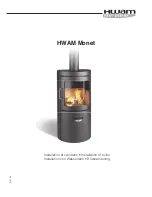
9
The discharge should terminate facing downward on the
exterior of the building in a position where discharging
(possibly boiling water & steam) will not create danger or
nuisance, but in an easily visible position, and not cause
damage to electrical components and wiring.
The discharge must not be over an entrance or a window
or any other type of public access.
A
IR
R
ELEASE
P
OINTS
:
These must be fitted at all high points where air naturally
collects and must be sited to facilitate complete filling of
the system.
The appliance has an integral sealed expansion vessel to
accommodate the increase of water volume when the
system is heated.
It can accept up to 7 litres (1.3 gal) of expansion water. If
the heating circuit has an unusually high water content,
an additional sealed expansion vessel must be fitted, for
GB refer to BS 7074 part 1 and for IE, refer to the current
edition of I.S. 813.
M
AINS
W
ATER
F
EED
- C
ENTRAL
H
EATING
:
A method for initially filling the heating system is supplied
with the connection kit. The filling loop is connected
between the cold water inlet and the central heating flow
connections, and incorporates a non-return valve. To
operate the filling loop, it is necessary to open both
quarter turn handles, once the required pressure has
been achieved, close both handles and disconnect the
hose in accordance with water byelaws. N
OTE
: The
installer should ensure that there are no leaks as frequent
filling of the heating system can lead to premature scaling
of the main exchanger and failure of hydraulic
components.
D
OMESTIC
W
ATER
:
The domestic water must be in accordance with the
relevant recommendation of BS 5546:1990. Copper
tubing to BS EN 1057:1996 is recommended for water
carrying pipe work and must be used for pipe work
carrying drinking water, a scale reducer should also be
used to reduce the risk of scale forming in the domestic
side of the heat exchanger.
VR003A
R
ESIDUAL
P
UMP
H
EAD
, D
ESIGNED
T
EMP
R
ISE
20oC
28/31 kW
24 kW










































